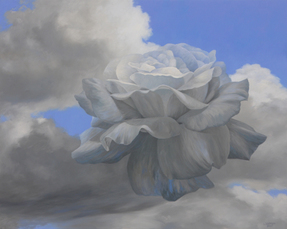 Cloudy With Chance of Teardrops, oil, 24" x 30" Cloudy With Chance of Teardrops, oil, 24" x 30" Every now and then, when perusing social media, I will come across a story or video about a blind artist. This brings up questions immediately: How do they do it? And also, why? Is it to show us the blind can do anything the sighted can, or is it a manifestation of creativity that can’t be expressed any other way? It’s an interesting topic to think about for a visually oriented person. I am taking part in a group exhibit at the Mount Baker Neighborhood Center for the Arts that includes at least one blind artist. This relatively new non-profit gallery in the Mount Baker ArtSpace Lofts building has a mission to bring together artists of all levels, and provides opportunities for artists with disabilities and the under-served community. I heard about their exhibit, “Flowers, Flores, Ubaxa,” through a call for art notice, and thought it would be an opportunity to put back on view one of my flower pieces from a few years ago. I occasionally participate in exhibits in neighborhoods in the greater Seattle area, in part because I have a good inventory of paintings and it’s gratifying to have them appreciated, and in part to explore and to meet the dedicated people working to put these shows together for their communities. When applying for this exhibit, I was intrigued to see they requested a visual description of the art along with the image, not the more esoteric artist’s statement. When I dropped off the painting in Mount Baker, I met the director, Barbara Oswald, who has very little sight, and she introduced me to a blind artist who would be exhibiting a painting for the first time. The artist had made a small acrylic painting of poppies floating on a blurred, textural background. The colors were unusual but harmonious, the contrast good, and she had achieved a delicate translucency in the petals. I learned from a casual search on the Internet that many people classified as blind can see a bit of light and form, which answers some of my questions. But there is one well-known blind painter in Turkey, Esref Armagan, who was born completely unsighted, and is self-taught. His work could be characterized as child-like or primitive, but the work of the late British artist Sargy Mann is quite sophisticated, despite increasing blindness that started early in his career. At the end of his life he was painting completely blind, by touch. As he said, so much of art goes on in the head. I also learned of a sighted artist, Roy Nachum, who incorporates poetic messages in Braille into his large oil paintings. The striking, realist images in minimalist color schemes have bumps sculpted under the paint so they can be read by touch. I wonder if, since color absorbs and reflects light at different wavelengths, if a method could be devised to experience color on a surface by variations in temperature. My own eyesight is not strong; I have worn glasses since second grade. A couple of years ago, I attended a touring Blind Café, where in a totally dark church basement, diners ate and listened to a concert, assisted by blind servers who shared their experiences with us. Those of us with normal vision are amazed by the skill with which the blind cope with everyday life, but they prefer we not be. When I try to imagine what I would do with my life were I to become blind, I assume I would concentrate my efforts on sculpture and/or music. Painting is difficult enough when I can see. But maybe it would be freeing, and take away some of the value judgement, to try it with the eyes closed. The exhibit “Flowers, Flores, Ubaxa 2016” will be at Mount Baker Neighborhood Center for the Arts April 1 through 28. There will be two receptions to meet the artists, Friday, April 1, from 4:30 to 7:30 p.m. and Sunday, April 3, from 3:00 to 6:00 p.m. The gallery is located near the Mt. Baker light rail station at 2919 Rainier Avenue South.
0 Comments
|
AuthorHere I will keep you up to date on my exhibits and other artistic endeavors. Archives
March 2024
Categories |
 RSS Feed
RSS Feed